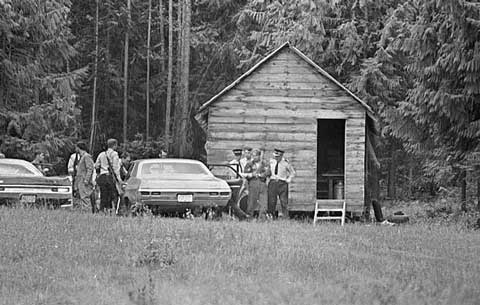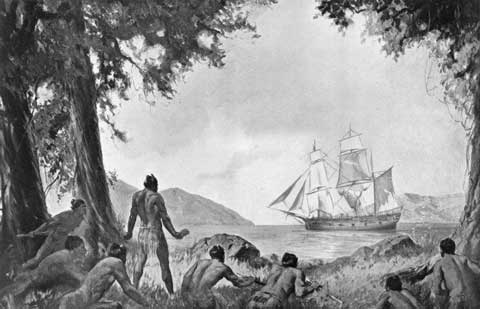Slade's Morgue:
Bed of Nails

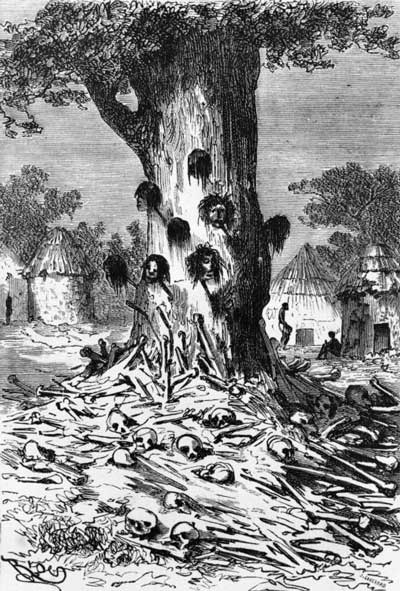
CANNIBAL TREE by Edouard Riou (1865)
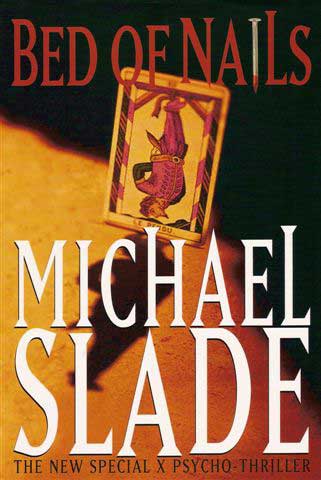
Canadian edition of BED OF NAILS
BED OF NAILS is Michael Slade's South Pacific cannibal killer thriller. Here's the story behind it.
Fee-fi-fo-fum,
I smell the blood of an Englishman,
Be he alive, or be he dead
I'll grind his bones to make my bread.
Cannibalism was well-established in young Slade's lurid imagination when he fell prey to that most seductive boyhood ritual: the 1955 Saturday matinee. For just 15 cents, the Ridge Theater delivered four hours of nail-biting adventure: two movies, an hour of Tom & Jerry cartoons, and a 1940s serial to lure you back next week.
The first film was always Jungle Jim.


Once that hook was in Slade's mind, it never stopped tugging. It still tugs today.
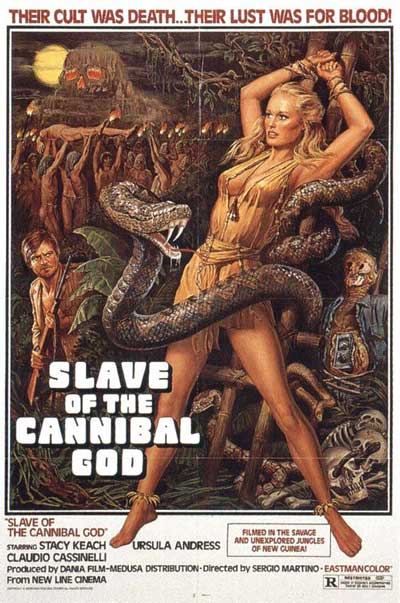
DR. NO's Ursula Andress in peril (1978)
"Filmed in the savage and unexplored jungles of New Guinea!"
Why must schools endeavor to bore students to death? Young Slade had no interest in learning that John Cabot discovered the cod banks off Newfoundland in 1497. Or that Sir Walter Raleigh introduced Virginia tobacco to Europe in 1578. Or that the lowly potato originally came from Peru. Or that Pierre Radisson's exploration of 1668 led to the formation of the Hudson's Bay Company.
No, for real adventure equal to the Saturday matinee, Slade wished to know what happened to Radisson as a teenager tortured by the Iroquois in 1652...
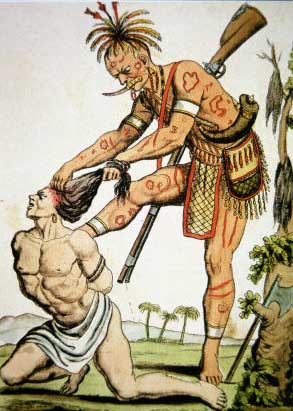
...and to Jesuit Fathers Brebeuf and Lalemant in 1649 while trying to convert the Iroquois to the Catholic Church (which, incidentally, was then conducting the Inquisition in Europe).
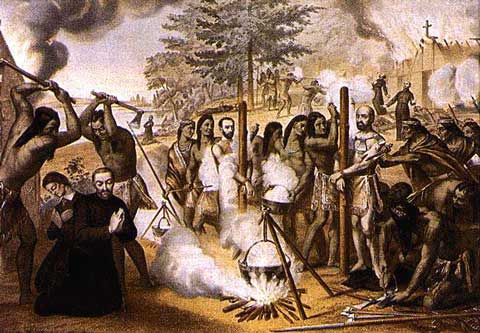
If Slade's elementary school was going to fall down on the job, he would educate himself. That's how, in 1958, he struck gold in the Paperback Cellar of Duthie Books. "Eureka!" Everything an 11-year-old explorer could hope to know about heart-pounding adventure in the Age of Discovery.
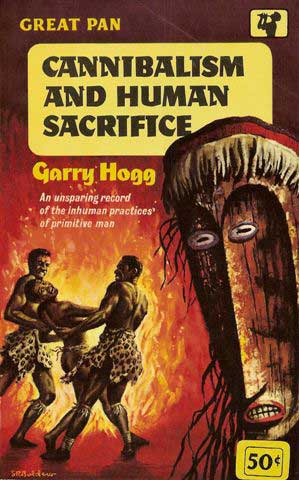
Forget that malarkey about Columbus and fear of sailing off the edge of a Flat Earth (bunkum perpetrated by Washington Irving in 1828). Intelligent Europeans had known the world was spherical since Aristotle. There were far greater dangers lurking in the New World, as depicted in the 1500s by Theodor de Bry:
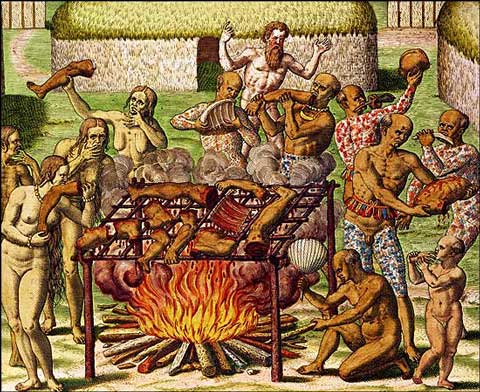
Note the explorer with his hands in the air
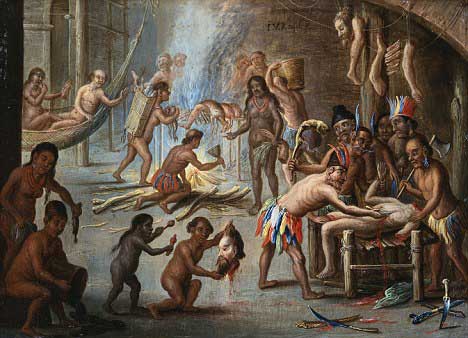
Note the explorer's head
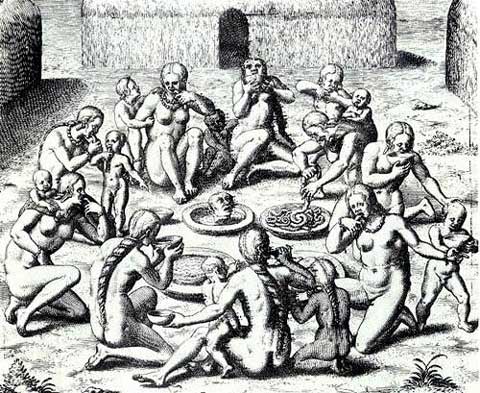
A family Thanksgiving dinner in the New World?
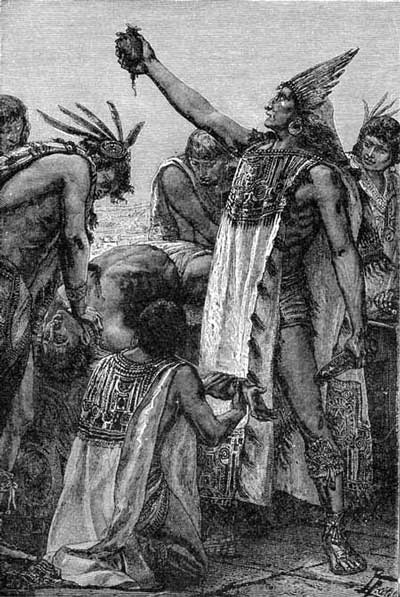
CANNIBAL CHIEF OFFERING HUMAN SACRIFICE
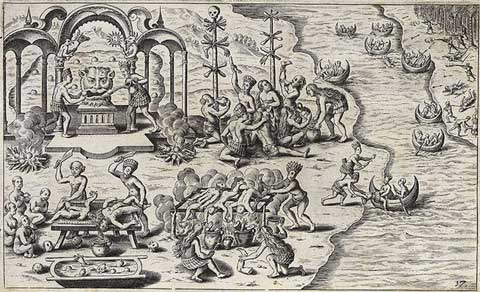
DEVIL WORSHIP AND CANNIBALISM IN SOUTH AMERICA (1621)
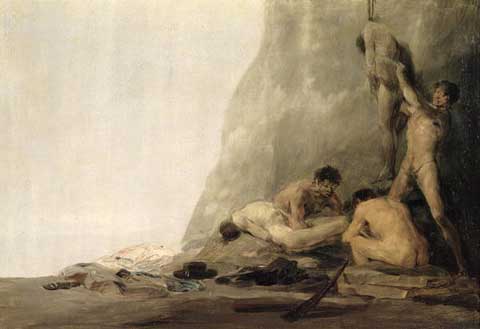
CANNIBALS PREPARING THEIR VICTIMS by Goya (1800 - 1808)
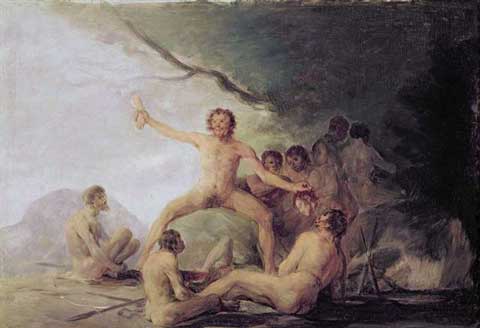
CANNIBALS SAVORING HUMAN REMAINS by Goya (1800 - 1808)
Decades later, the tugging of that boyhood psychological hook would inspire Slade to write BED OF NAILS (2003). Here he is as a cannibal in the article "Psycho-Thriller Master Plumbs His Demons" in THE GEORGIA STRAIGHT, photo by Alex Waterhouse-Hayward, and prop arm by Christ Stanley of Flesh & Fantasy.

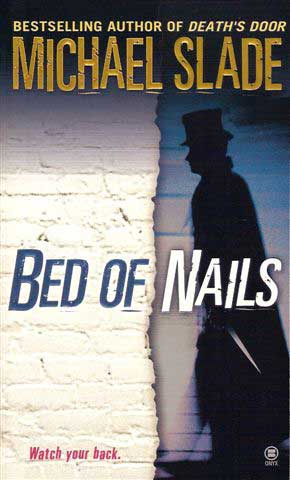
American edition of BED OF NAILS
Isolated in Ashworth House, an asylum for the criminally insane, is the Ripper. He believes he's the notorious butcher who terrorized Whitechapel more than a century ago. He talks of time travel, infinity, and the occult. In the black hole of his imagination, he reenacts the crimes. In the darkness of his heart, he still craves the thrill of the kill. Thank God he can't escape.But with such an ingenious mind for murder, the Ripper doesn't have
to - and the ghastly crimes he can manipulate from his padded cell are taking Inspector Zinc Chandler of Special X - the psycho-hunters of the Mounted Police - on a trail of unspeakable carnage that leads to the idyllic Cook Islands, where human sacrifice and cannibalism is more than a dark and perverted chapter in history. It's tradition.Come and get it.

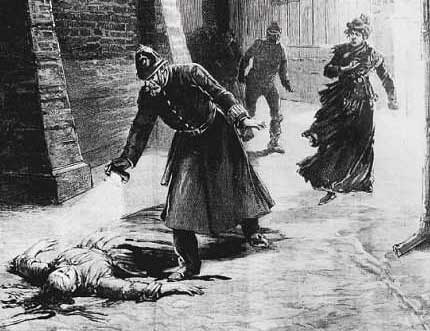
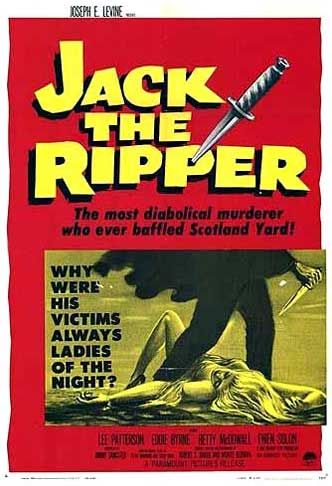
In 1959 - the year after young Slade read CANNIBALISM AND HUMAN SACRIFICE - he consumed not only the first non-fiction book on Jack the Ripper since the 1930s, but also - despite being underage - snuck in to see the film JACK THE RIPPER. Two years later, his mother took him to London, where he tracked down all five Ripper murder sites. Back then, the scenes were frozen in time as if the year was still 1888 (see RIPPER). Today, when packaged Ripper walking tours leave on the hour, you get to stare at cobblestones in front of modern buildings while the guide informs you that's what's left of Mitre Square.
Organs were found to be missing from three Ripper victims: Annie Chapman's uterus, Catherine Eddowes' kidney and womb, and Mary Jane Kelly's heart. Why?
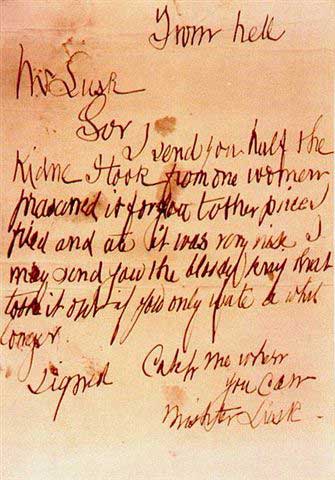
"From hell" letter
On October 16, 1888, this letter - along with half a human kidney preserved in ethanol - was received by George Lusk, head of the Whitechapel Vigilance Committee.
From hell
Mr Lusk,
Sir
I send you half the Kidne I took from one women prasarved it for you tother piece I fried and ate it was very nise...
So, was Jack the Ripper a cannibal?
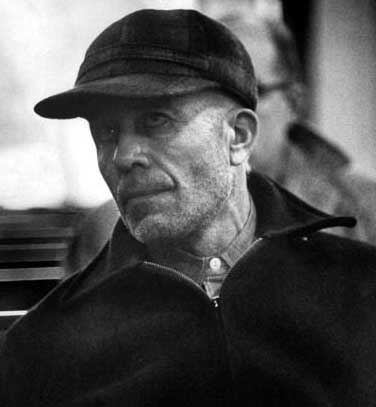
Of all American psychos, none is more iconic than Ed Gein, whose cultural status developed in the years 1957 to 1960. This chilling face is copyrighted by LIFE magazine, and reproduced here under "fair use" to illustrate its hypnotic effect on young Slade back then. Like no other photo, it captures Gein's madness.
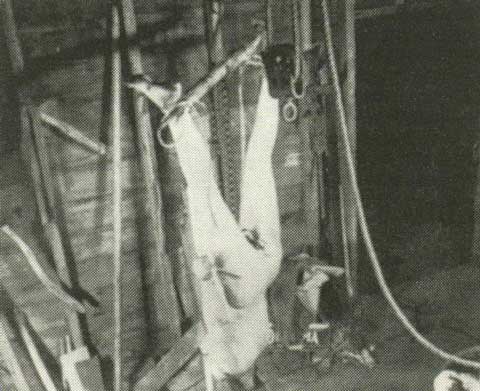
Headless body "dressed" like a deer in Ed Gein's shed
Ed Gein was obsessed with cannibals, headhunters, and his dead mother. From grave-robbing, he turned to murder to try to become her. When police searched the Plainfield Ghoul's unkempt Wisconsin farmhouse, they found soup bowls made from skulls, chairs upholstered with human skin, a shoebox full of female genitalia, faces stuffed with newspapers and mounted on a wall like hunting trophies, and a "mammary vest" flayed from the torso of a woman, which Gein would wear to pretend he was his mother.
His mother's room was tidy, and kept like a shrine. In a frying pan on the stove was the heart of the headless woman "dressed" like a deer in Gein's shed. Was eating it another way for him to become his mother?
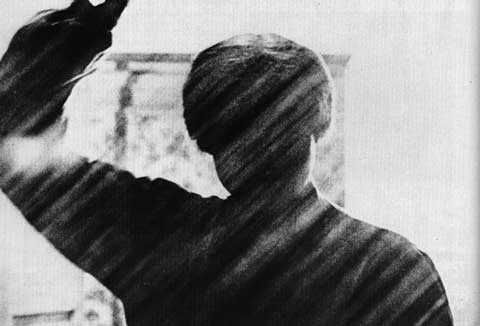
PSYCHO (1960)
So iconic is Ed Gein that he spawned three cultural icons:
1/ PSYCHO's Norman Bates.

2/ THE TEXAS CHAINSAW MASSACRE's Leatherface.

3/ THE SILENCE OF THE LAMBS' Buffalo Bill and Hannibal "the Cannibal" Lecter.

Over the years that followed the 1950s hook, Slade expanded his rogues' gallery of cannibal killers.
From his Scottish relatives came the legend of Alexander "Sawney" Bean(e), the head of a cannibal clan that lived in a Galloway cave in 16th century Scotland. According to THE NEWGATE CALENDAR, Bean's incestuous family waylaid, butchered, and devoured hundred of travelers.
Go ye not by Gallowa'
Come bide a while, my frein
I'll tell ye o' the dangers there
Beware o' Sawney Bean.
There's nae body kens that he bides there
For his face is seldom seen
But tae meet his eye is tae meet your fate
At the hands o' Sawney Bean.
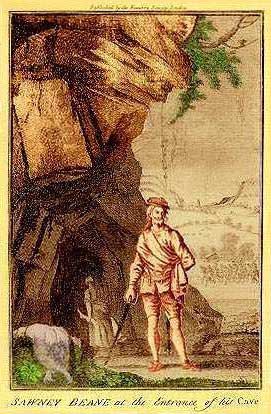
SAWNEY BEAN AT THE ENTRANCE OF HIS CAVE
Note the woman lugging dismembered legs
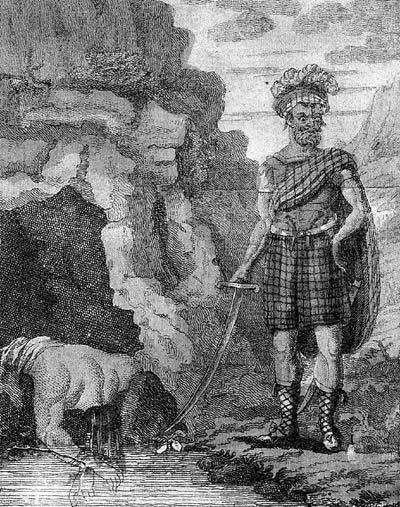
Sawney Bean in tartan
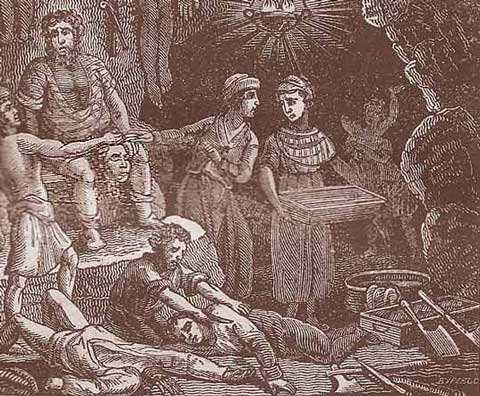
Inside Bean's cannibal cave
On delving into history, Slade turned up Albert Fish (1870 - 1936).
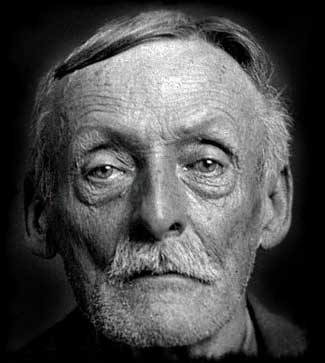
In 1928, Fish lured 10-year-old Grace Budd away from her Manhattan home, and turned her "meat" - as he called it - into a cannibal stew, complete with carrots, onions, and bacon strips.
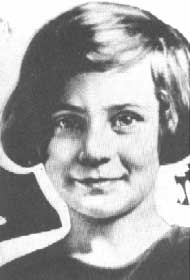
Grace Budd
As the oldest man put to death in New York State, Fish short-circuited Sing Sing Prison's electric chair. An Xray revealed 29 needles inserted into his groin.
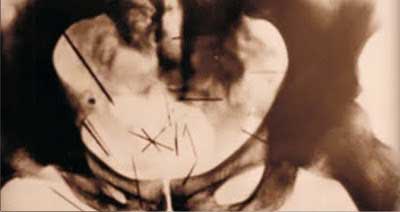
Other cannibals in Slade's rogues' gallery (and BED OF NAILS) are...
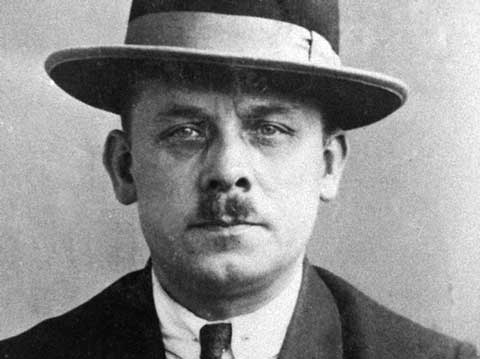
Fritz Haarmann (Germany)
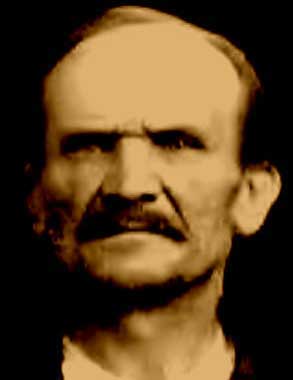
Georg Karl Grossmann (Germany)
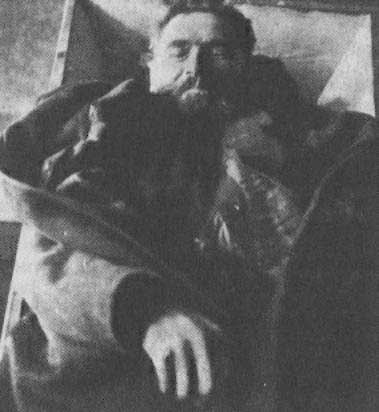
Karl Denke (Germany)

Joachim Kroll (Germany)
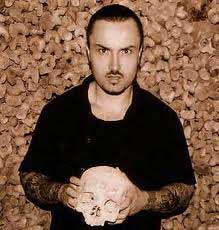
Nicolas Claux (France)

David Harker (Britain)
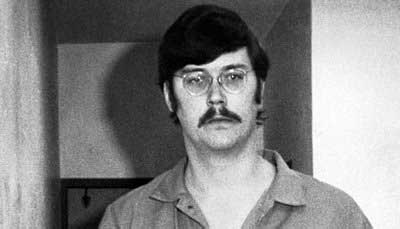
Edmund Kemper (America)
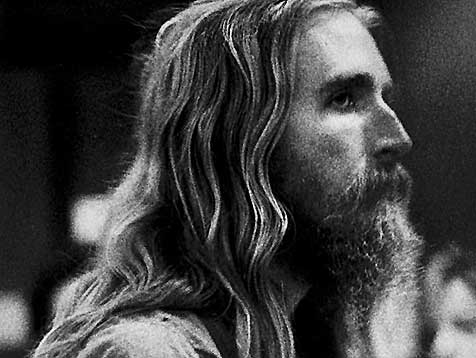
Daniel Rakowitz (America)
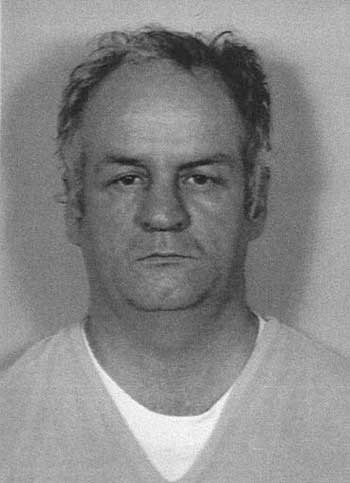
Arthur Shawcross (America)

Gary Heidnik (America)
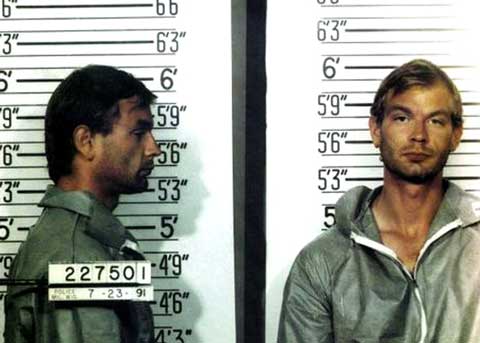
Jeffrey Dahmer (America)

Andrei Chikatilo (Russia)
While practicing law, Slade never defended or prosecuted a cannibal killer. But he did have a brush with one. Sort of.
On September 5, 1970, while high on a mix of LSD and alcohol, Dale Nelson murdered 8 people (including 5 children) in central British Columbia. The Mounted Police captured him the following day.
Nelson's plea of insanity failed at his murder trial. He was sentenced to life at the British Columbia Penitentiary. Because he had cut the stomach out of a 7-year-old girl and eaten its undigested cereal, Nelson was nicknamed "Cornflakes" by the other prisoners.
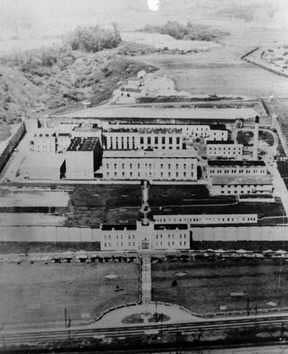
The B.C. Penitentiary
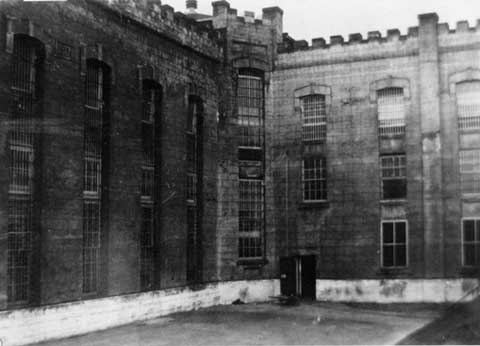
Inside the B.C. Pen
The B.C. Pen opened in 1878. For 102 years, it jailed maximum security inmates. By the 1970s, it was an antiquated, overcrowded timebomb waiting to explode.
On February 17, 1975, Slade worked late at the office while his partner gave a speech to the Lawyers' Inn. The plan was to meet later for a nightcap.
When the phone rang, Slade thought it was him. Instead, it was the B.C. Pen, trying to track Slade down. A former client had seized a physical training instuctor and was holding him with a homemade knife to his throat in a toilet stall off the prison gym. Between the guards and the hostage-taker, over 200 inmates were milling around. They might riot if forced to return to their cells. The warden wished Slade to attend the prison as soon as possible to convince the agitated con to give up the knife.
"He's suffering a psychiatric outbreak," warned the Pen. "He's pretty shook up."
Having been in the thick of the Gastown Riot in 1971 (police on horseback charged and clubbed protesters in Maple Tree Square out front of Slade's office), he knew the physical danger of getting caught up in chaos. Not responding, however, wasn't an option. Next day's headline could read "10 Killed at B.C. Pen. Lawyer Failed To Show."
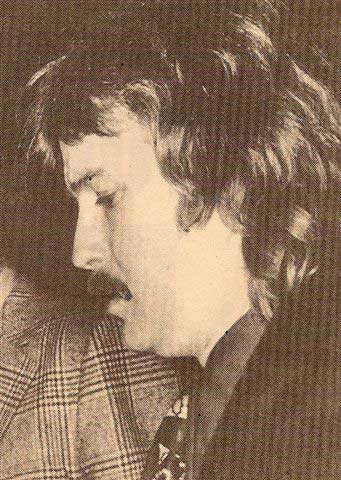
Slade arrives at the hostage crisis
Swept by spotlights, the B.C. Pen was ringed by cops with shotguns and German shepherds. On meeting Slade, the warden flipped open the cylinder of his revolver to check its rounds. Beyond a throng of news photographers, a radio talk show host broadcasted live.
To reach the toilet meant parting the mob of 200+ inmates. Slade's firm had recently prosecuted the assize: all the murders tried in Vancouver over a two-month stretch. Consequently, the firm had put several of these cons away for life. Back then, a lawyer could both prosecute and defend.
Having survived that gauntlet, Slade found his former client in a desperate state. The B.C. Pen was a "chicken coop" in which he was "treated like an animal." Several times, he'd slashed himself to get psychiatric help. Now, he was "sick of all the head games," "bug juice," and being "thrown in the hole." The final straw was how "Cornflakes" bugged him. "What did you have for breakfast?" "What did you have for lunch?"
Reaching a deal coaxed the overwrought man to drop up the knife. The warden agreed to transfer him to the treatment center at another prison, and that no charges would be laid.
Shortly after midnight, a closed car sped Slade, his client, and the warden away from the prison. When he got home at 4 a.m., Slade finally had that drink.
There were 5 more hostage-takings that year. One resulted in death. The B.C. Pen was closed in 1980, then demolished. Dale Nelson - "Cornflakes" - died of cancer.

Cover art UNQUIET GRAVE by Charles Vess
(copyright, used with permission)
What pulled BED OF NAILS together was the World Horror Convention in Seattle, Washington in 2001. Slade was its Guest of Honor.
The program included a Ghost Tour of Spooky Seattle. The bus ventured 20 miles out to Maltby Cemetery, dubbed "one of the most evil places on Earth" by RIPLEY'S BELIEVE IT OR NOT. Legend says the haunted graveyard was founded in the 1800s by a family of satanists dead against burial in sacred ground. At its center is a sinkhole called the Thirteen Steps to Hell, a cement staircase that descends nowhere. Reach the bottom step - unlucky 13 - and the descender may get a bone-chilling glimpse of hell.
What a good spot, Slade thought, for bloody murder:
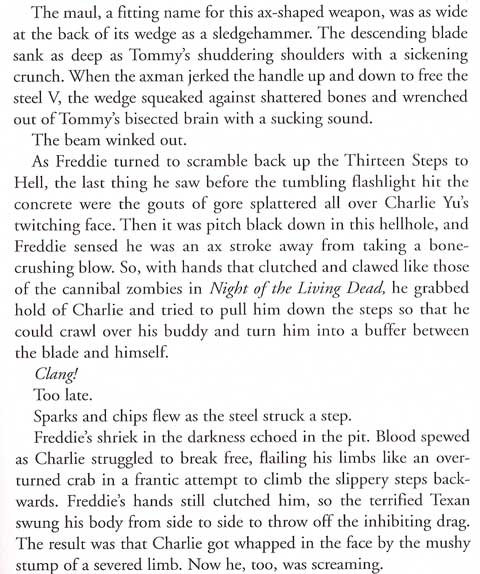
On its way back to the horror convention, the ghost tour bus got stuck in traffic near the 4100 block of Twelfth Avenue N.E. The guide told the busload there was nowhere to park, but that's the house where Ted Bundy lived from 1969 to 1974, while he was killing Seattle coeds. At one point - the (false) urban legend goes - Bundy lined 4 severed heads up on the mantel.
The bus almost flipped as its load shifted to that side for a gawk.
What a good spot, Slade thought, for another murder.

Ted Bundy in a fit of rage at his trial

Bite mark evidence at Bundy's trial
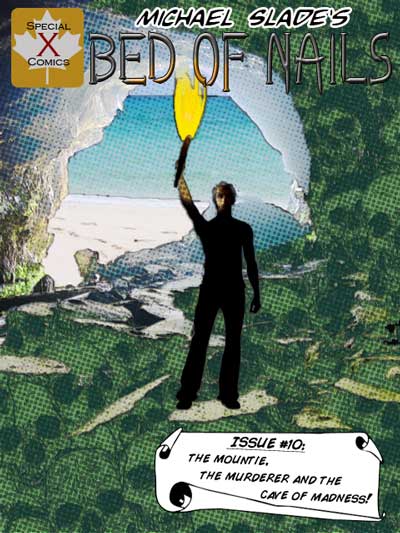
Note the skulls in the cave walls
From deep within the high-security ward of a mental hospital, the Ripper plots revenge against Inspector Zinc Chandler. When Chandler responds to a bizarre murder at a hotel in Vancouver - a Hollywood producer suspended upside down like the Hanged Man card in a tarot deck, with a crown of nails hammered into his head - the Mountie becomes enmeshed in a deadly battle with the most implacable of psychotic enemies.To solve that murder and the horrific killings that follow at the foot of Maltby Cemetery's Thirteen Steps to Hell and Ted Bundy's house, Chandler must look back in time to 1888, when London was terrorized by its own demented Ripper, and into the weird world of H.P. Lovecraft's "Cthulhu Mythos."
His search takes him from a high-speed car chase with guns blazing in the streets of Vancouver to the fantasy realm of the Goths at the World Horror Convention in Seattle to a nail-biting climax in the Kingdom of Bones on the cannibal island of Tangaroa in the South Pacific, where Survivor is the game and Chandler an unwilling contestant.

"BED OF NAILS electroshocks the reader into turning the pages long into the night. It's a get-under-your-skin thriller with machine-gun dialogue and impressive real-world research (check out the sources at the book's end). It's time to round up the unusual suspects. BED OF NAILS is one heck of a ride, and definitely not for the faint of heart." - CNN.com
"BED OF NAILS is another nerve-wracking entry in Slade's unique series that blends cunning whodunits with creepy psychos derived from his criminal defense history." - Bev Vincent, Cemetery Dance
"BED OF NAILS is a Lovecraft-laced paean to South Seas cannibalism. It sports some inspired, twisted set pieces right off the bat. In typical 'Slade-of-hand,' you're never quite sure who the killer is until the 'final reel' when all the stops are pulled out. All bets are off in a Slade book; anyone can deep six at any time. This bloody good yarn is well told, and seemlessly blends intensely researched historical fact and present day drama. Reading it's akin to watching an antiquated SERGEANT RENFREW OF THE ROYAL MOUNTED movie serial jacked up with brains, twisted sex, highly sylized violence, and buckets of gore." - Chris Alexander, Rue Morgue
"Michael Slade is undeniably the best thriller writer of our generation." - Del Howison of Dark Delicacies
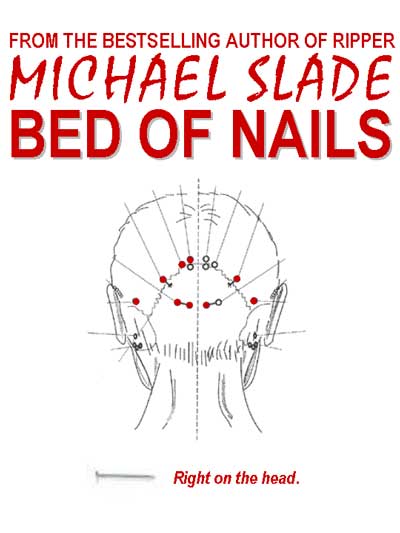
"Rife with fabulously gruesome historical cannibalism details, more than a hint of Tarot- and Goth-lore, a hefty dash of Lovecraft's Mythos, as well as subtle World Horror Convention in-jokes, BED OF NAILS manages to straddle both the big blockbuster thriller and small, quirky novel-of-terror camps." - William D. Gagliani, The Chiaroscuro (ChiZine)
"Slade's scary style is shaped by his alter ego's early experiences. He writes about things that horrified him as a child. Slade's method is to reach down deep into his soul, find something that scares the hell out of him, and spin it into a story that will resonate." - The Vancouver Sun
"DEMON SPAWN. In 2001, Michael Slade was Guest of Honor at the World Horror Convention in Seattle. That conference forms the backdrop for BED OF NAILS. On a panel entitled 'How to Write a Horror Bestseller: Is There a Demon You Can Sell Your Soul To?', Slade's answer was affirmative. 'That demon is YOU. Because if you want to tap into horrors that will cause readers to shiver and shake, you must delve down into the landscape of your own damned soul.' Slade is a raconteur par excellence who moves effortlessly from illustrations from his most gruesome court cases to scary anecdotes about exploring cannibal caves as research for BED OF NAILS."
- Montreal Mirror
"Now for something you can sink your teeth into. Slade takes horror to a new level. Your constant companions during this graphic read will be the Ripper, who - in his delusional state - believes he can time-travel back to London and become Jack the Ripper, and the Goth, who visits the Ripper at an insane asylum to be instructed in the ways of the occult. Their objective is to kill Inspector Zinc Chandler. With grisly murders, sexy women, and kinky sex, this one is destined for the bestseller list."
- Rose & Thorn

"BED OF NAILS could stand tall beside the horror-ific works of Stephen King or Anne Rice." - Halifax Daily News
"Slade parlays the experiences of childhood terror into graphic, unflinching novels full of action, suspense, and intensity that turn the screws on his readers." - The Georgia Straight
"Michael Slade is an acknowledged expert in horror. GHOUL was selected by the Horror Writers Association as one of the top 40 horror novels of all time, and is cited as one of the 10 best in THE A TO Z ENCYCLOPEDIA OF SERIAL KILLERS. BED OF NAILS revisits the storyline from GHOUL. Uncomfortable reading, a Slade book has more squirm than a bucketful of worms, and on more than a couple of occasions, I've been crawling the ceiling as I worked my way through one of his terrifying page-turners. What makes Slade books so addictive is not just well-written shocks, but also well-thought-out whodunits a la Agatha Christie." - The Outlook
"Gritty authenticity." - Winnipeg Free Press
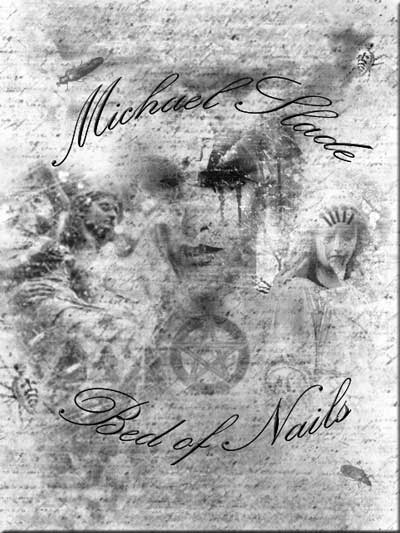
So, back to young Slade's Age of Discovery in elementary school.
Hogg's book taught him the history of ravenous maneaters lurking out there. Africa had Nigeria, the Congo Basin, the Leopard Societies of Sierra Leone, and Kenya's Mau Mau Uprising (1952 - 1960). The New World had the Aztecs, the Amazon Basin, and - in Slade's own back yard - the Kwakiutl Hamatsa cult of Vancouver Island (see KAMIKAZE). The greatest peril, however, was in the South Pacific.
In 20,000 LEAGUES UNDER THE SEA (1954)...
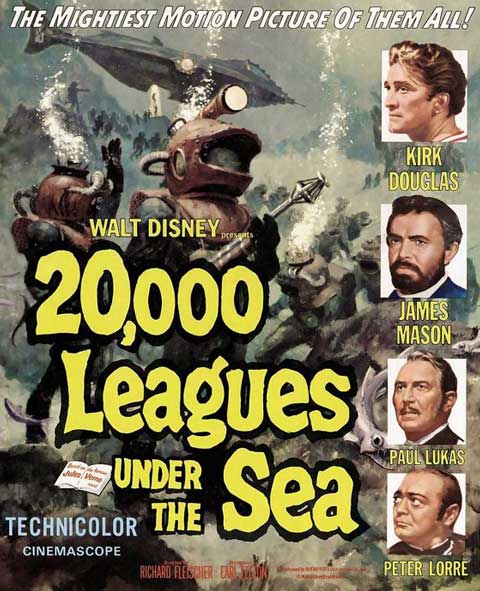
...Captain Nemo's Nautilus gets stranded on a reef off the coast of New Guinea. When Ned Land goes ashore, he discovers a hoard of human skulls and a cannibal up a tree. Chased by the islanders, Ned runs for his life, and soon the cannibals swarm around the submarine.
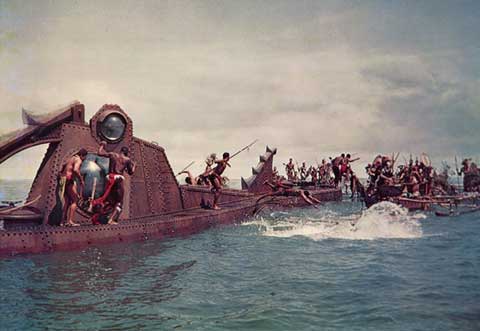
Is it any wonder that Slade's favorite explorer is Captain James Cook (1728 - 1779)...
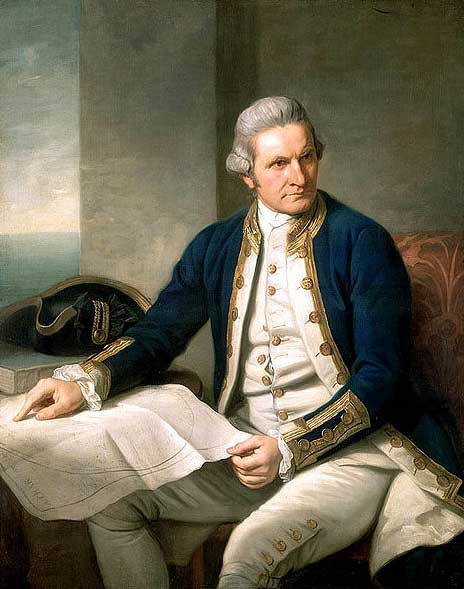
CAPTAIN JAMES COOK by Nathaniel Dance (1775)
...who suffered a similar fate in Kealakekua Bay, Hawaii, on February 14, 1779.
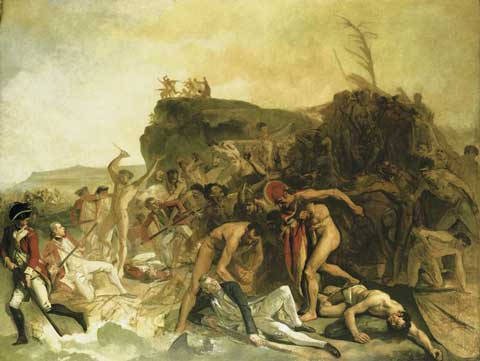
THE DEATH OF CAPTAIN JAMES COOK,
unfinished painting by Johann Zoffany (c. 1795)
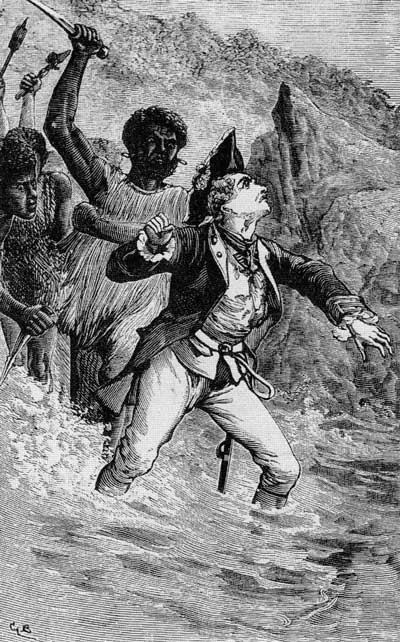
DEATH OF CAPTAIN COOK by Gordon Browne (1895)
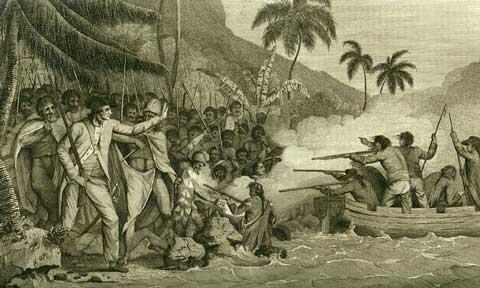
Book illustration from 1784
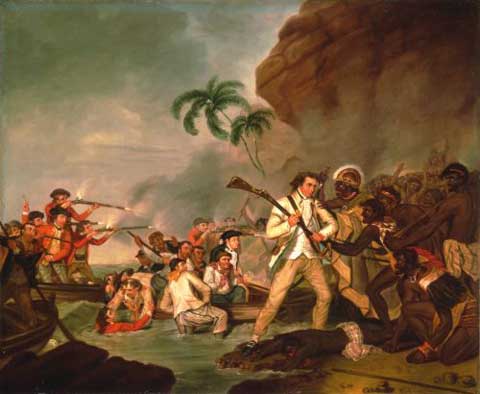
DEATH OF CAPTAIN COOK by George Carter (c. 1783)
John Webber was the official artist on Cook's 3rd - and final - voyage.
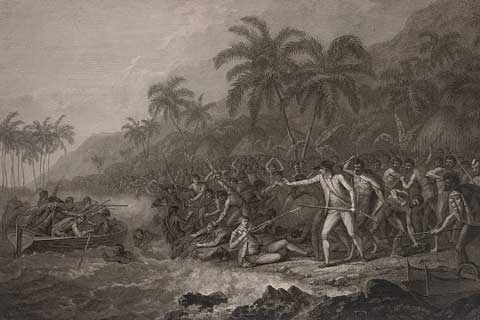
THE DEATH OF CAPTAIN COOK by John Webber (c. 1785)
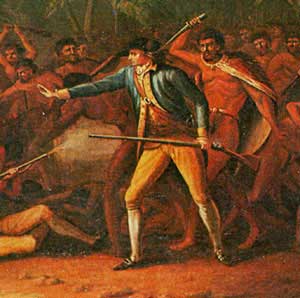
Webber detail
John Cleveley's brother James was a carpenter on Cook's ship. Supposedly, this was rendered from sketches James made.
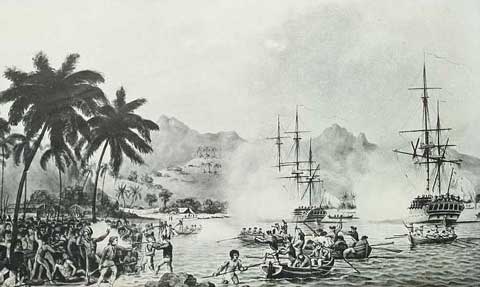
DEATH OF COOK by John Cleveley (1784)
In most of the above depictions, note how Cook is romanticized as a peacemaker. With his back to the islanders, he signals to his crewmen to hold their fire. In Cleveley's picture, the gunsmoke forms a halo around Cook's head.
In 2004, an earlier rendering by Cleveley surfaced. In it, note how Cook fights for his life.
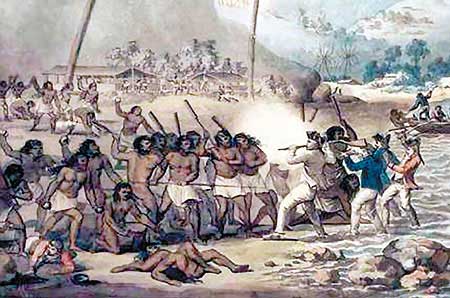
Was Cleveley pressured to change his original depiction based on his brother's sketches to one that made Cook look passive and heroic, so as to bring his death within the Age of Enlightenment, the 17th century philosophy that reason was the primary source of legitimacy and authority?
In this image, "apotheosis" means the exultation of Cook to the rank of a god.

THE APOTHEOSIS OF CAPTAIN COOK by Phillipe de Loutherbourg (1794)
Captain Cook - legend says - was eaten by the Hawaiians. He wasn't. The islanders weren't cannibals, but they did believe that a man's power resided in his bones. The captain's body was cooked to remove his skeleton. When bargaining got his remains returned to the ship, Cook's crew received his long bones, skull, scalp, hands, and feet.
The cooking of his flesh gave rise to the cannibal legend.
Cook wasn't the only explorer to die in the Pacific. Ferdinand Magellan - the first to cross the ocean - was killed by Philippine islanders in 1521.
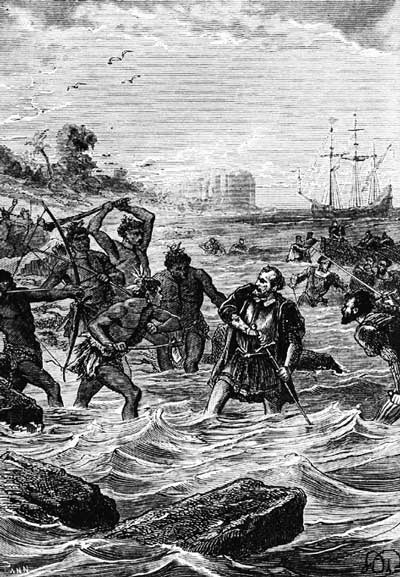
The death of Magellan
The Hawaiians may not have been cannibals, but many South Seas islanders were.
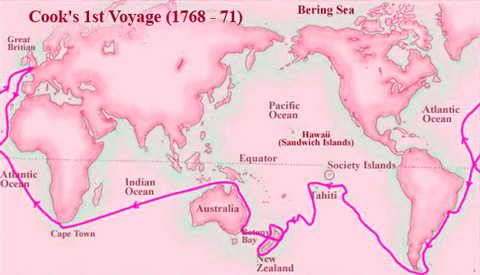
During his 1st voyage, Cook circumnavigated and mapped New Zealand.
Note the patu, the striking club in the standing Maori's hand. Its blow was a horizontal thrust straight from the shoulder at an enemy's temple. Or - if the adversary could be gripped by the hair - driven up under the ribs or jaw. The tattooed warrior below holds a patu.
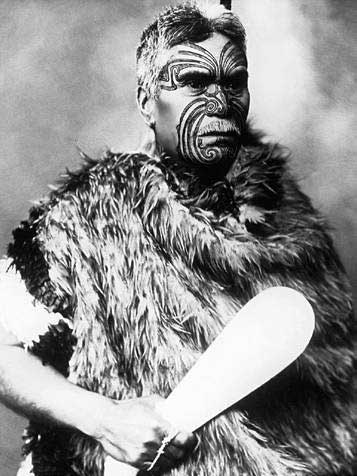
With tongues stuck out to express their defiance, tattooed Maoris with feathers in their hair attacked Cook and his crew as they stepped ashore.
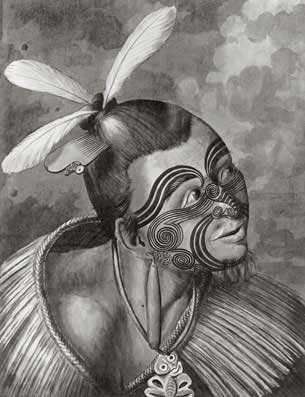
NEW ZEALAND MAN by Sydney Parkinson, an artist on Cook's ship (c. 1770)

In a series of bloody skirmishes, Cook's men shot 10 Maoris. They watched New Zealanders eat the flesh of those they'd killed in battle, and later studied the mokomokai - the preserved heads of tattooed enemy warriors - that Maoris brought to HMS Endeavour.
As trophies of war, mokomokai were displayed on the Maoris' marae - sacred rectangular meeting places - to be mocked. Exchanging them was how New Zealand tribes made peace. During the Musket Wars of the early 19th century, Maoris bartered mokomokai for British guns.
Here's Major-General Horatio Gordon Robley with his collection of tattooed heads (note the patu in his hand):
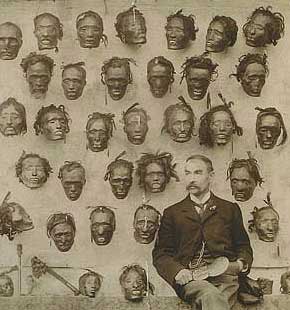
Cook found the Aborigines of Australia hostile too.
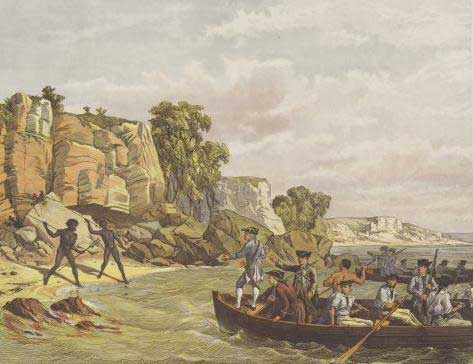
Cook attempts to land in Botany Bay
Like Captain Nemo's Nautilus in 20,000 LEAGUES UNDER THE SEA, Cook's ship ran aground in the shark-infested waters of the Great Barrier Reef. Though less voracious than the Maori of New Zealand, the indigenous Australians were cannibals as well.
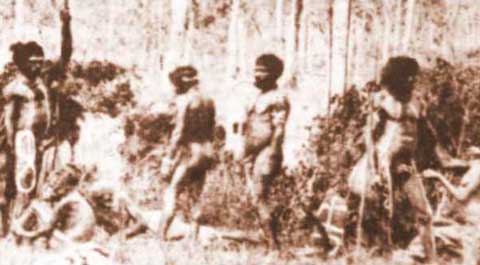
The explorers, however, weren't troubled as they repaired the Endeavour onshore.
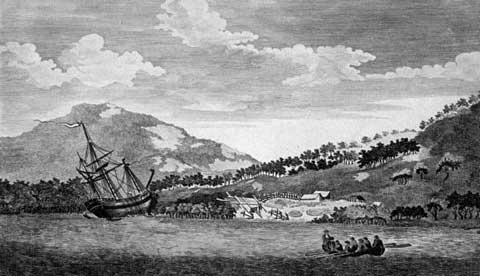
While sailing home, Cook stopped in Batavia, Java (now Indonesia) for more repairs. Over 30 of his crewmen died from diseases contracted there. These paintings were done in Batavia in the late 1600s by a German gunsmith with the Dutch East India Company.
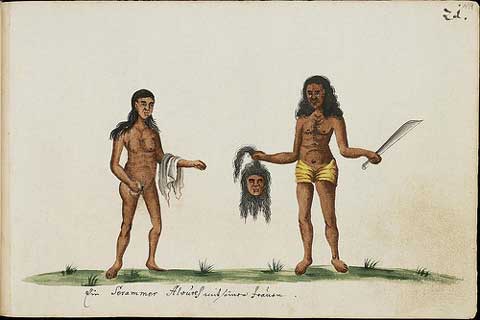
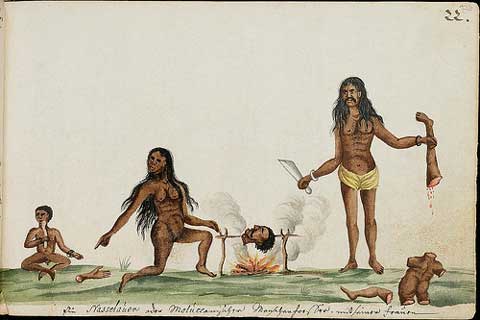
Forty years later - in 1809 - the Boyd sailed from Australia to New Zealand to fetch a cargo of timber. Onboard was Te Ara, the son of a Maori chief. For some reason, the ship's captain had him flogged. On arriving in Whangaroa Harbor, Te Ara told the Maori and asked for utu: revenge.
The Maori lured some on the ship ashore and killed them with clubs and axes. The bodies were stripped and eaten.
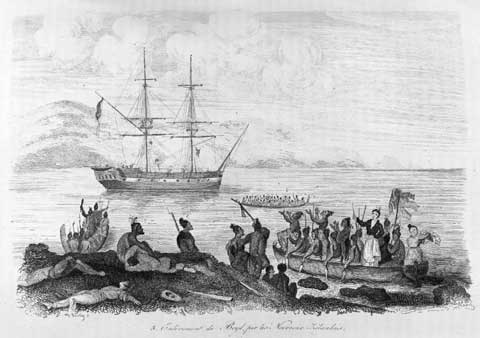
THE BOYD INCIDENT by Louis Auguste Sainson (1839)
That night, disguised in the foreign clothes, cannibals seized the ship. Almost all aboard were killed, but five survived by climbing the mast and hiding in the rigging. From there, they watched the butchering of their shipmates below.
The Maori spent days ransacking the ship's cargo. Until their chief sparked a flint amid smashed barrels of gunpowder. The Boyd blew sky-high.
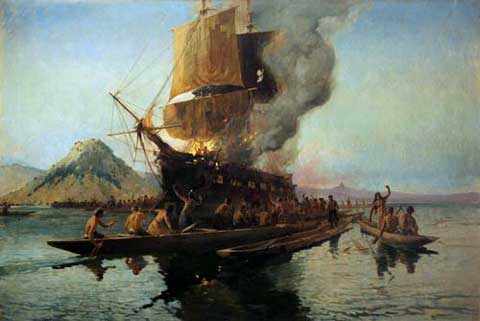
THE BURNING OF THE BOYD by Walter Wright (1908)
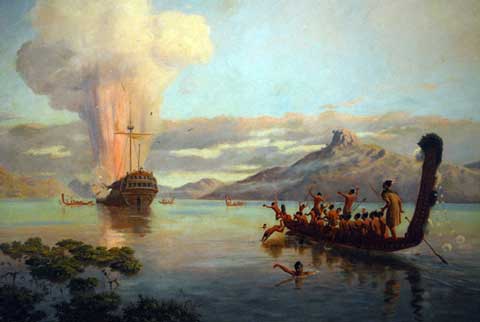
THE BLOWING UP OF THE BOYD by Louis John Steele and Kennett Watkins (1889)
In all, 66 Europeans died. When City of Edinburgh arrived as a rescue ship, its crew found the shoreline piled with gnawed human bones.
The "Boyd Massacre" - as it was dubbed - caused shipping to all but cease and missionary zeal to wane. A pamphlet circulating among sailors warned them about the "Cannibal Isles." "Touch not that cursed shore" of New Zealand on risk of getting eaten.
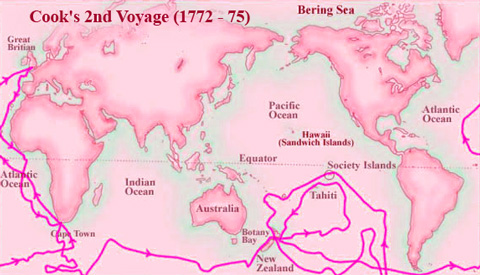
For his 2nd voyage, Cook set sail with 2 ships: HMS Resolution and HMS Adventure. A mishap like the shipwreck on the Great Barrier Reef would not strand the explorers.
On nearing New Zealand in October 1773, the windjammers got separated when a storm blew the Adventure out to sea. To satisfy his morbid curiosity, Cook let Maori cannibals feast on flesh aboard the Resolution. Then, alone, the ship departed for the Antarctic.
Damaged, the Adventure anchored in New Zealand for repairs. After a shore crew of 10 men were slaughtered and eaten by the Maori, that ship returned to Britain.
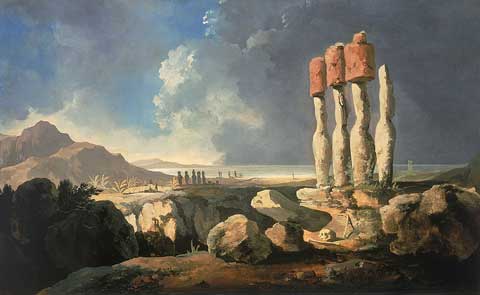
A VIEW OF THE MONUMENTS OF EASTER ISLAND, RAPA NUI by William Hodges (1775)
Note the skull and long bone on the ground
In March 1774, Cook reached Easter Island. William Hodges, an artist aboard the Resolution, painted the colossal stone statues - moia - for which the world's most remote inhabited island is famous. Scholars are still unable to definitively explain the function of the idols.
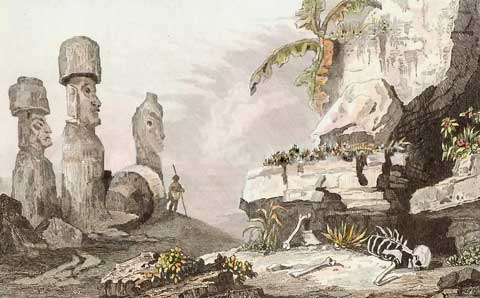
MONUMENTS IN EASTER ISLAND by William Hodges (1777)
Note the skeleton
In addition to the spiritual reasons for South Seas cannibalism, Easter Island had another motive. To roll the huge quarried idols on felled logs, the islanders destroyed their limited forest. That degraded the topsoil, wiped out most plants, and drove animals to extinction. Descending into civil war, they ate each other to survive.
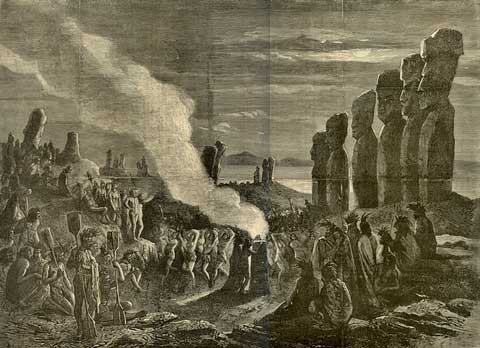
IDOL FESTIVAL IN EASTER ISLAND
Missionaries, who followed Cook, converted the cannibals.
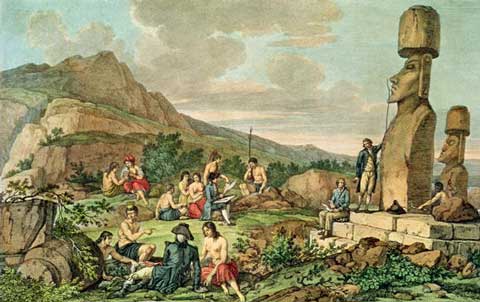
In July 1774, Cook discovered the Fijian Island of Vatoa. He named it Turtle Island. The Fijians fled on seeing Cook's ship, so he left gifts onshore.
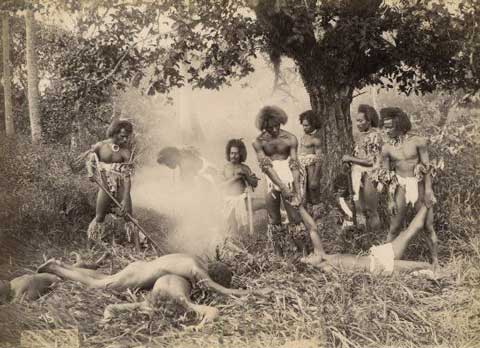
THE BANQUET by Thomas Andrew (c. late 1880s)
A posed Fijian cannibal feast
(National Library of New Zealand)
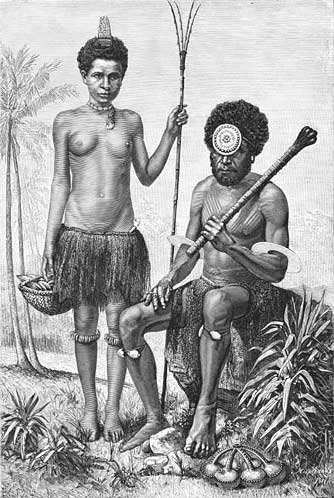
Fijian chief and his wife
The Fijians became the most feared maneaters in the South Pacific. Their warrior gods were cannibals who demanded human sacrifice. Eating an enemy was the ultimate insult a Fijian could impose, for in a culture of ancestor worship, the disgrace stuck to the victim's family. Fiji usurped New Zealand as "the Cannibal Isles."
William Bligh was a sailing master on Cook's 3rd voyage. After the Mutiny on the Bounty in 1789, Captain Bligh and 18 men were set adrift in a boat. Chased by cannibals in what is now Bligh Water, Fiji, they were forced to row more than 4,000 miles to the Dutch East Indies.

THE MUTINEERS TURNING BLIGH ADRIFT by Robert Dodd (1790)
In the early 19th century, Fijian Chief Ratu Udre Udre ate at least 872 people (see THE GUINNESS BOOK OF WORLD RECORDS). He kept a stone for every human he ate, and had them placed by his tomb. The chief devoured the entire body, but favored the head.
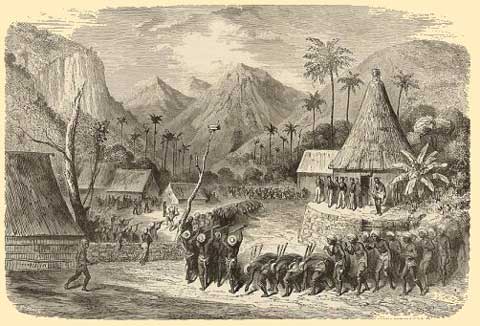
DANCE OF THE FIJIAN WARRIORS
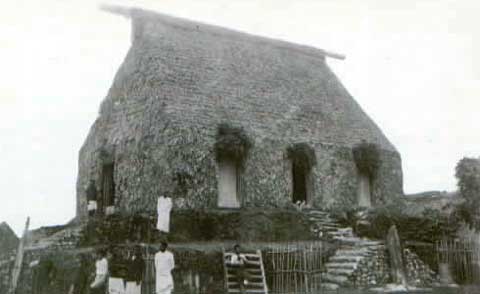
Fijian cannibal temple
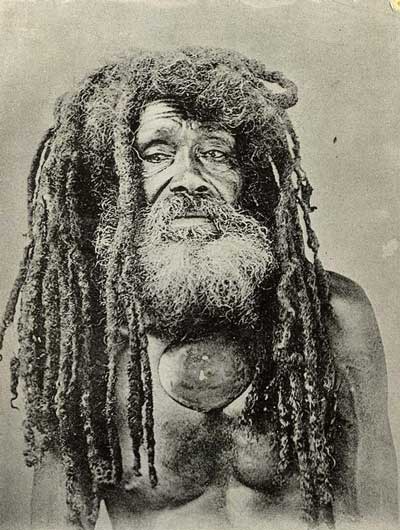
A Fijian cannibal
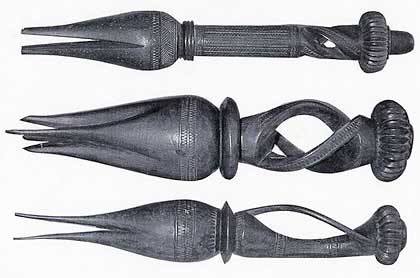
Fijian cannibal forks
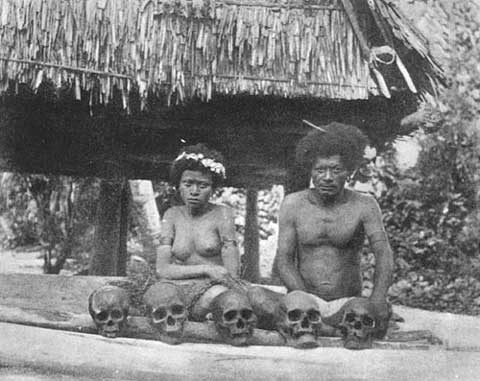
South Seas cannibal trophies
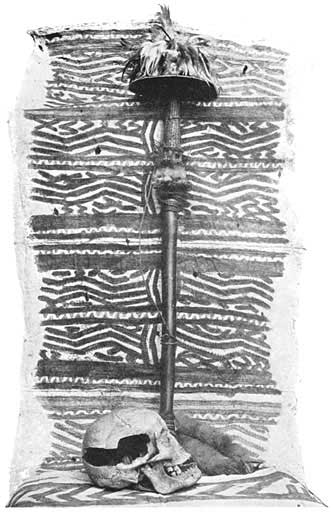
Fijian cannibal relics
In 1813, the Hunter stopped at Fiji for sandalwood. When a skirmish broke out onshore, Peter Dillon, Charles Savage, and 3 others took refuge on top of "Dillon's Rock." During the standoff, Savage and another man were killed by the Fijians, and - according to Dillon - were "dissected, baked, and devoured" on the beach.
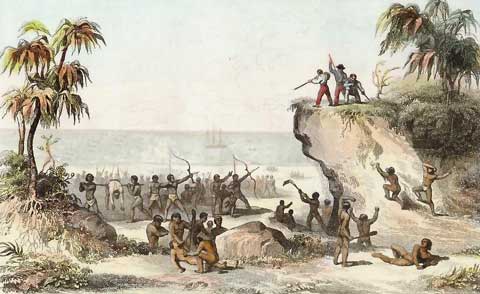
The siege atop Dillon's Rock
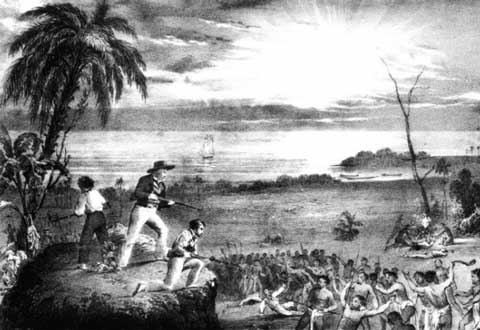
Reverend Thomas Baker of the London Missionary Society was killed and eaten in Fiji in 1867. Baker tried to take a comb from the cannibal chief's hair. Touching a chief's head was strictly forbidden, so the missionary and 7 Methodist followers were clubbed to death and cooked. "We ate everything but his boots," one cannibal later confessed.
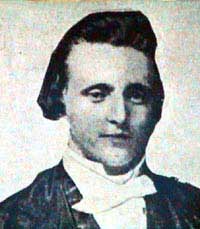
Reverend Thomas Baker
Baker's boot is in the Fiji Museum. The battleax that killed him is in the village. In 2003, Fijians held a matanigasau reconciliation ceremony with Baker's descendents to lift a curse from the village.

THE LANDING OF CAPTAIN COOK AT ERROMANGO, ONE OF THE NEW HEBRIDES
From Fiji, Cook sailed to the New Hebrides (now Vanuatu) in July 1774. When the Melanesians on Erromango gave him a hostile reception, Cook was forced to open fire and kill their chief.
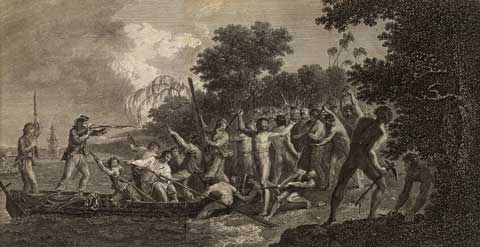
THE LANDING AT ERROMANGO by William Hodges (1777)
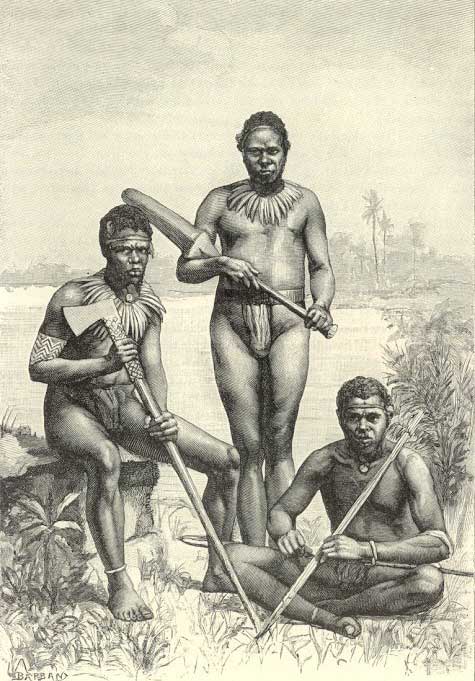
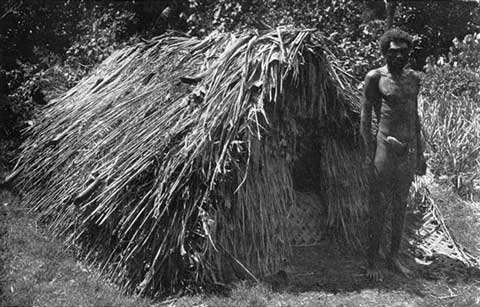
New Hebrides cannibal by his hut
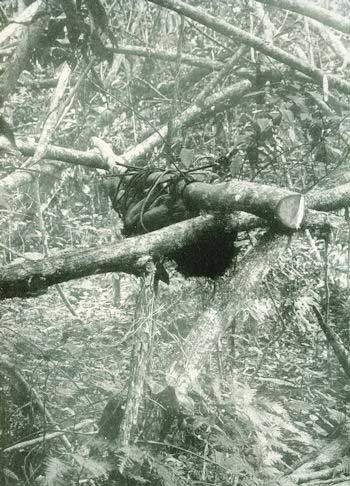
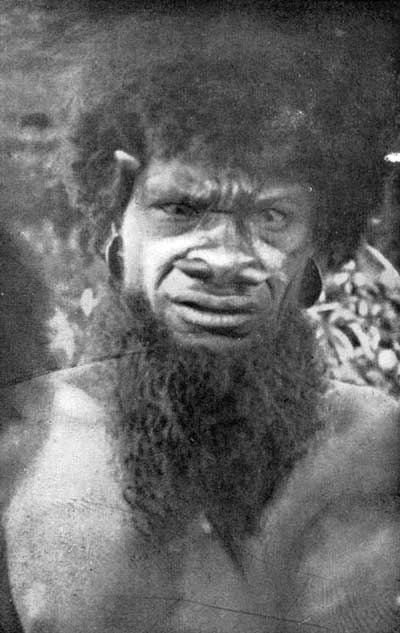
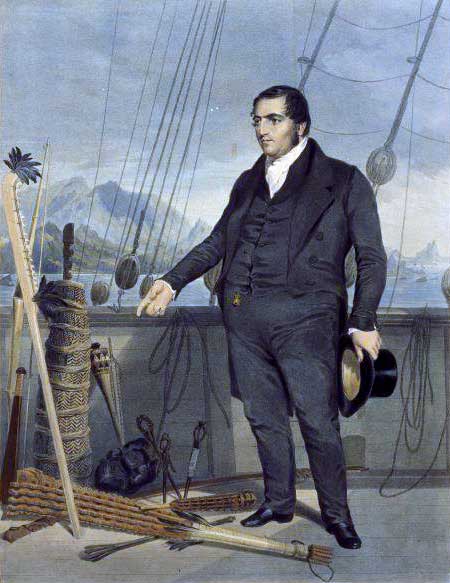
JOHN WILLIAMS, MISSIONARY TO THE SOUTH SEA ISLANDS by Henry Anelay (c. 1840)
(National Library of New Zealand)
By the 1830s, Reverend John Williams of the London Missionary Society was known as "the Apostle of Polynesia." He was instrumental in converting Tahiti, Samoa, and the Cook Islands.
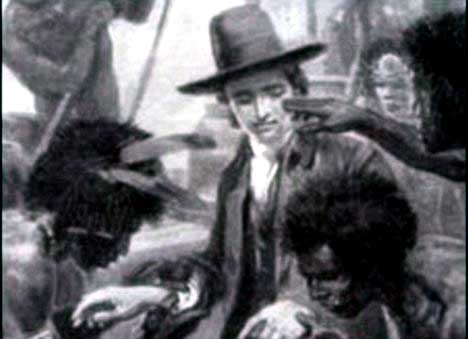
Note the cannibals' interest in John Williams' flesh
In 1839, Williams' mission ship Camden anchored in Dillons Bay off Erromango. He and fellow missionary James Harris went ashore to estabish a Christian outpost.
Days before, sandalwood traders had killed some islanders. Hostile New Hebrideans attacked Harris and clubbed him to death. Williams turned and ran for the sea. When the cannibals caught him in the shallows, he was bludgeoned, speared, and shot with arrows. Both missionaries were eaten.
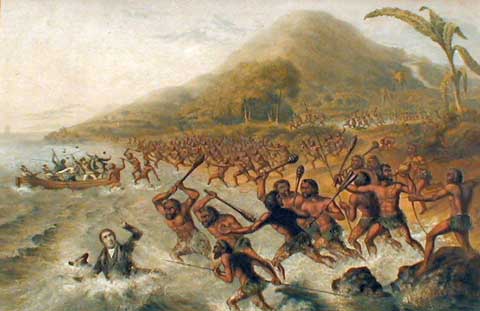
THE MASSACRE OF THE LAMENTED MISSIONARY, THE REV. J. WILLIAMS, AND MR. HARRIS by George Baxter (1841)
After Reverend Williams' death, missionaries called Erromango "Martyr's Island." In 2009, Erromango held a reconciliation ceremony with Williams' descendents. Dillons Bay (named after the sandalwood trader besieged by cannibals atop the rock in Fiji) was renamed Williams Bay.
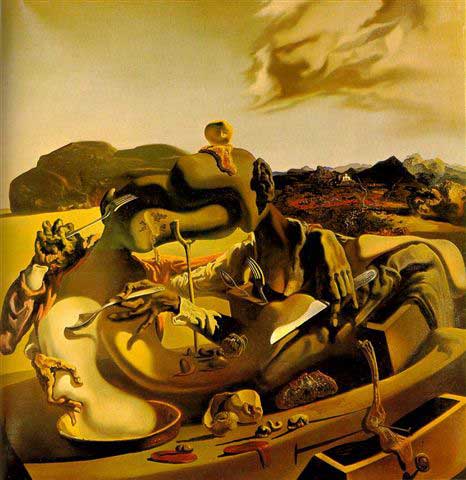
AUTUMN CANNIBALISM by Salvador Dali (1936)
"History is written by the victors," Winston Churchill said. Concerning South Seas cannibalism, the victors were European explorers, imperialists, and missionaries. The "historical facts" above are ethnocentric, so the historian in Slade knows full well the need to question everything. As evidenced by the paintings of Cook's death in Hawaii.
That, however, was irrelevant to the thriller writer in Slade for BED OF NAILS. All that matters to the plot is the influence of such ethnocentric history on the shared psychosis of the Ripper and the Goth.
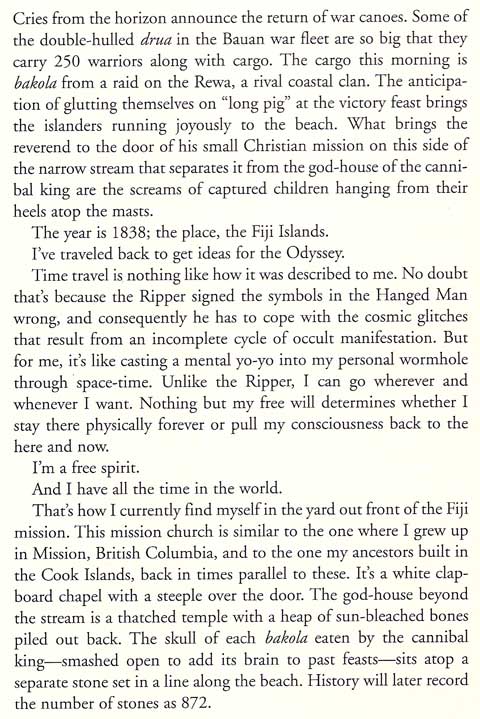
The inspiration for the Odyssey to the South Pacific - the ruse through which the Ripper and the Goth plan to cannibalize Zinc Chandler - sprang from several sources. In 1816, the Romantic poets Lord Byron and Percy Bysshe Shelley, Shelley's wife Mary, and Dr. John Polidori spent a rainy summer at Lake Geneva, Switzerland. One night, while reading aloud from TALES OF THE DEAD, Byron suggested they each write a ghost story. Out of that, Mary Shelley penned FRANKENSTEIN, and Polidori wrote "THE VAMPYRE" - the first vampire story in English - which led to Bram Stoker's DRACULA.
So, thought Slade, why not do a similar spin-off from the World Horror Convention? And that begged the question: "Where do I send the writers?"
In 1977, Slade spent several weeks in Western Samoa. From that came the urge to one day write a South Pacific thriller. Robert Louis Stevenson spent his final years (1890 - 94) in Western Samoa...
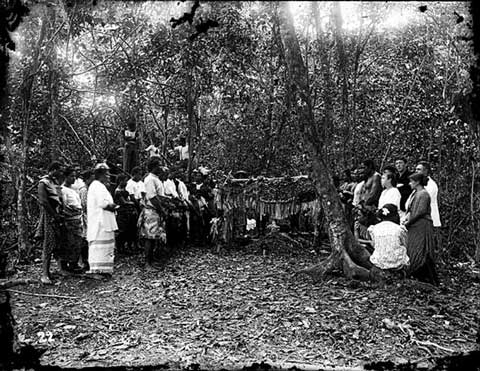
Stevenson's burial atop Mount Vaea on Upolu Island
...and that's where Reverend John Williams' gnawed remains are buried, but Samoa's cannibal history wasn't voracious enough for BED OF NAILS.
Instead, Slade found the answer in Cook's 3rd voyage.
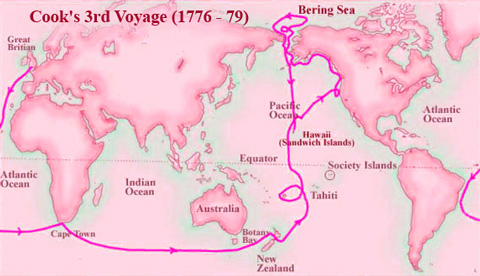
On his way north from New Zealand to Vancouver Island (see RIPPER), the Arctic, and his death in Hawaii, Cook made two stops. One was at Tahiti, where he witnessed a human sacrifice.
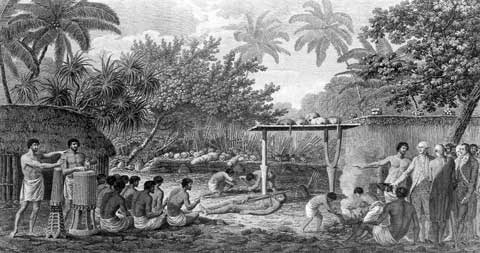
A HUMAN SACRIFICE, IN A MARAE, IN TAHITI, IN THE PRESENCE OF CAPTAIN COOK by John Webber (1777)
Note the skulls in the background
Cook's other stop was off Atiu, which he discovered on his way to Tahiti. There, on April 3, 1777, he sent three boats ashore to fetch feed for his two ships' animals.
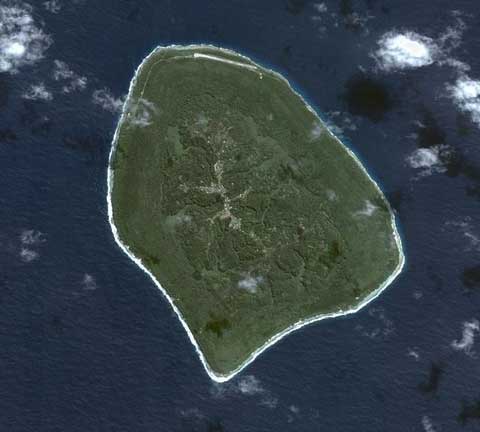
Atiu
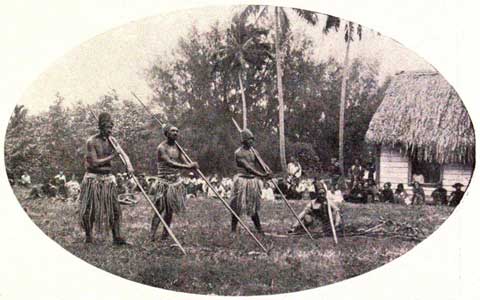
Atiu warriors
On Slade's 2002 Odyssey to the South Pacific to research and "live" BED OF NAILS, he snapped these photos of the Atiu marae.

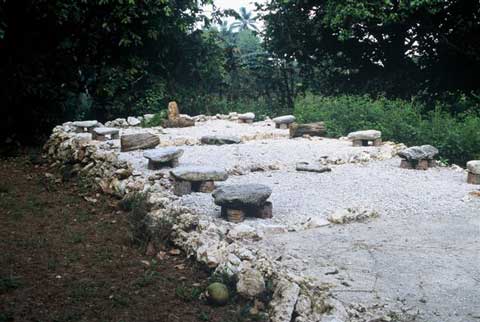
A huge tiki idol of Tangaroa - the Atiuans' cannibal fertility god - stood in the center of the marae as Cook's crew watched the islanders dance and dig a big underground oven for a feast.

Tangaroa idol
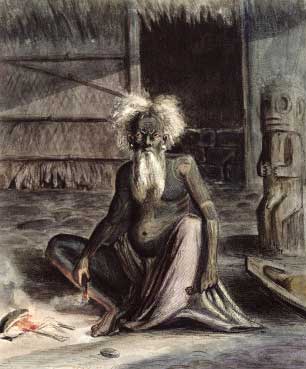
TIKI IDOL by Maximilien Radiquet (c. 1841 - 48)
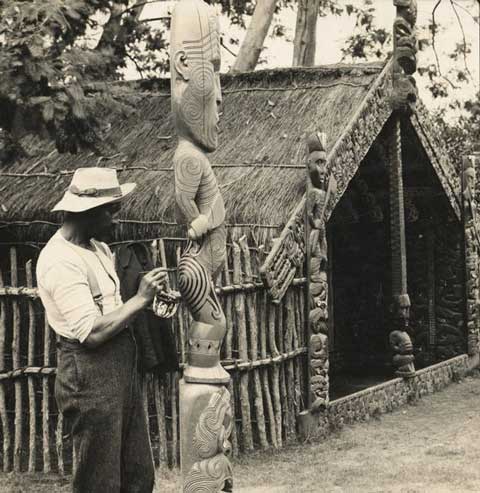
Tattooing a tiki idol (1905)
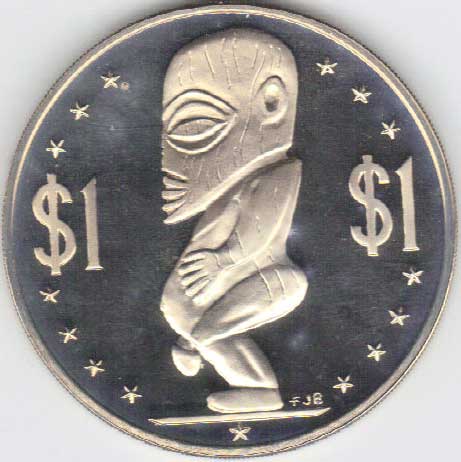
Tangaroa on a Cook Islands coin

Tangaroa on Cook Islands money
Suspecting they were about to become the feast, Cook's crew used a blast of gunpowder to shock and awe the Atiuans into letting them retreat.
Forty-six years passed before the next European landed: Reverend John Williams of the London Missionary Society in 1823. What he encountered was hell on earth. So bloodthirsty was Rongomatane, Atiu's cannibal chief, that he had all but wiped out the populace on the neighboring islands of Mauke and Mitiaro.
The Cook Islands offered the ideal setting for BED OF NAILS. Not only did Atiu - the 3rd largest island - rival Fiji in its cannibal history, but the nation was named after Captain Cook, and "cook" was a double entendre.
Inspector Zinc Chandler - like Slade before him - flies to Rarotonga, and checks into paradise.



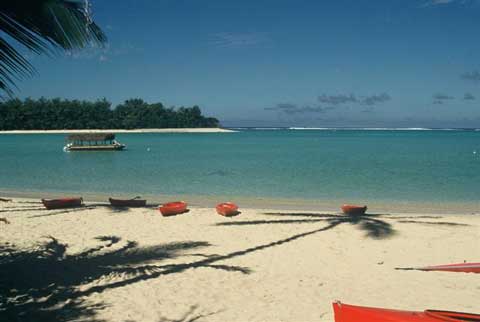
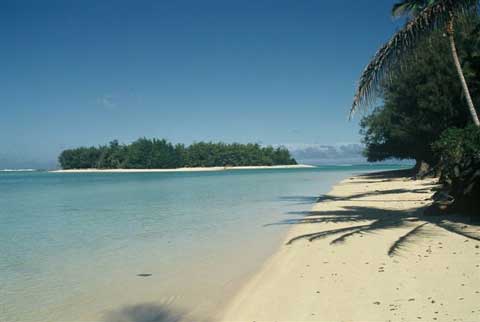
About 1350 A.D., a fleet of Rarotongan canoes embarked from this lagoon on the Great Migration that resulted in the settling of New Zealand by the Maori whose cannibalism so intrigued Captain Cook.
Here, too, is where the first Europeans landed in 1814. Marauding sandalwood hunters off the Cumberland hauled island women back to their ship for sex. When the intruders desecrated the chief's marae, riled Rarotongans chased down several sailors, hacked them apart, and ate them. Ann Butcher, the captain's consort, and the only European woman ever cannibalized, was also cooked in the oven.
From Rarotonga, Slade flew to Aitutaki.

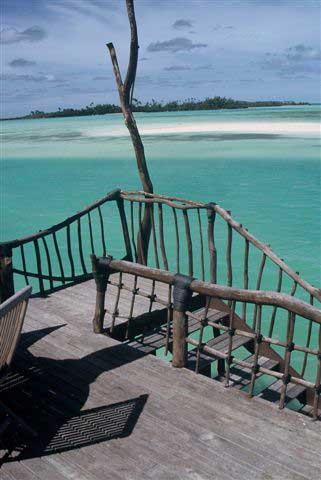
Slade's writing platform

Slade's plotting hammock
Of all the islands in the South Pacific, Aitutaki has the finest lagoon.

The sand stretches as far as the eye can see.
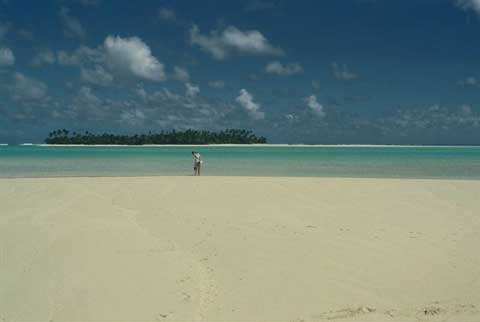
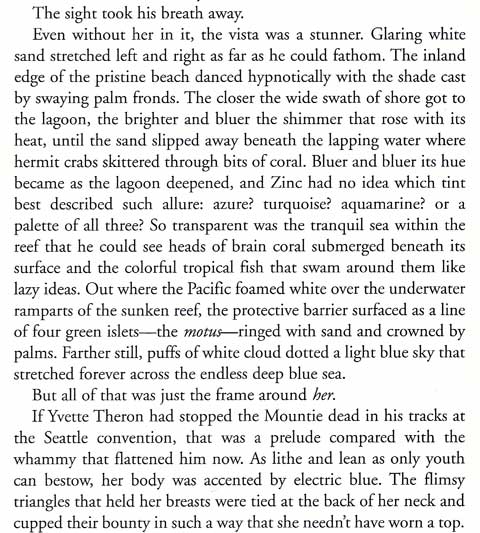
Why would an author sit in a room trying to imagine a story if he/she could go to the actual setting and act out the plot? That's how you get the details right to suspend disbelief in the reader. Clear vision is better than smoke and mirrors.
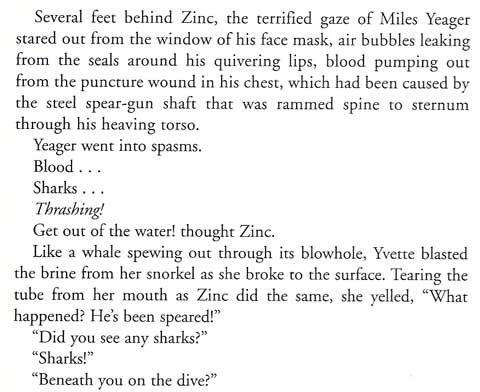
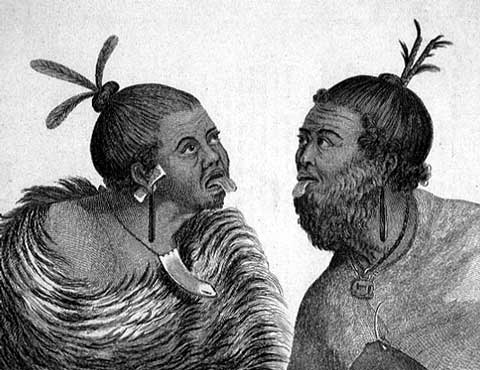
THE MANNER IN WHICH SOUTH SEAS WARRIORS DEFY THEIR ENEMIES by Sydney Parkinson (1773)
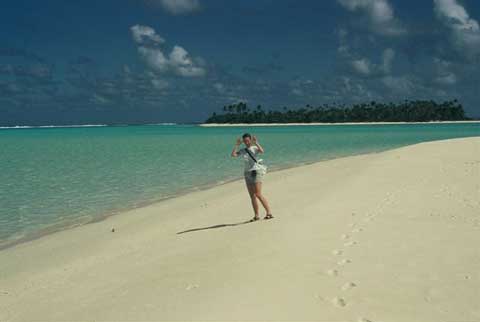
"When in Rome..."
Pink Slade, tongue stuck out, defies her "enemy" during a plot dispute
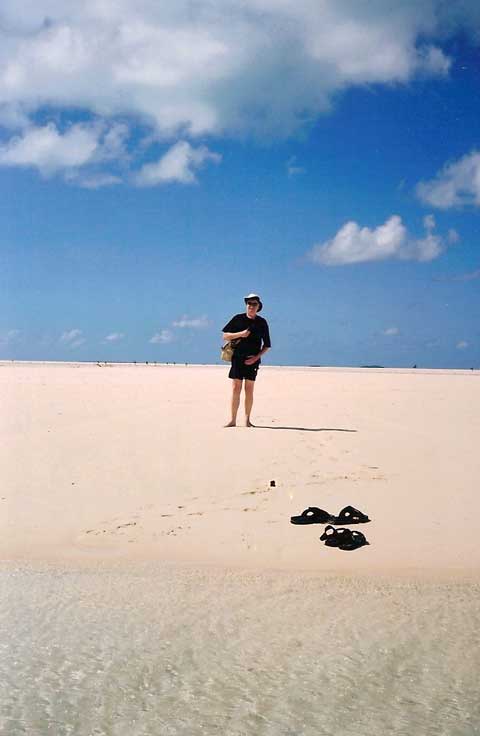
"Enemy" Slade
Note the background to Aitutaki's lagoon
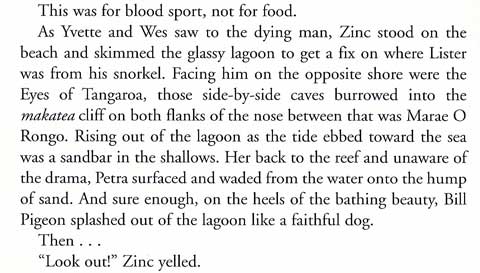
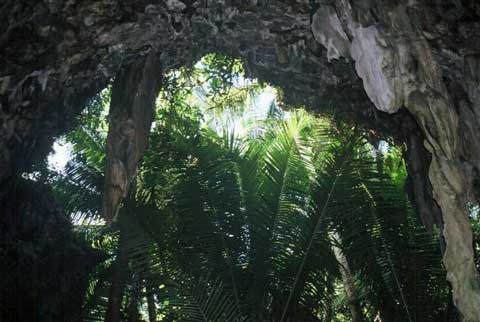
Looking out through the Eyes of Tangaroa
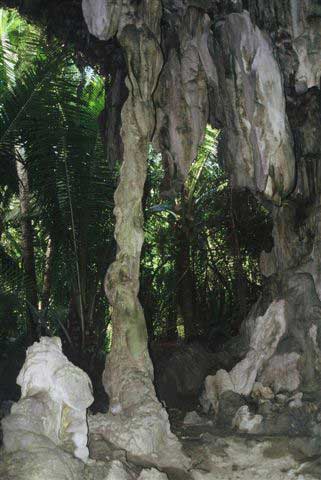
Whether it's Jungle Jim in CANNIBAL ATTACK at the Ridge Theater, or more recent movies at a theater near you...
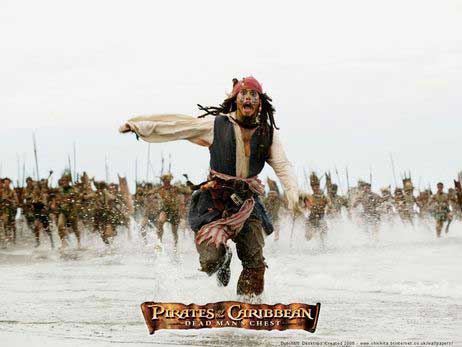
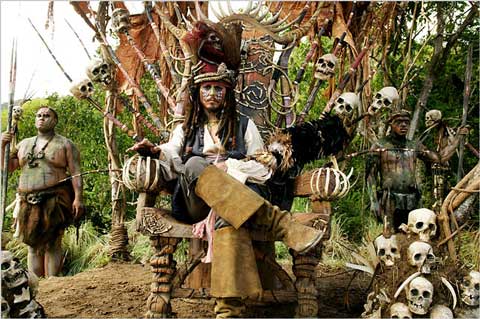
...exploring a cannibal kingdom of bones is a thrilling fantasy.
From standing in Ripper's Corner when Mitre Square was still there (see RIPPER), to venturing behind the Iron Curtain at the height of the Cold War, to standing atop the Great Pyramid of Cheops in Egypt (see DEATH'S DOOR), to sitting on the tomb where Poe and Lovecraft sat before (see GHOUL), to tracking the snake-infested ruins of the Great Wall of China (see CUTTHROAT), to wandering off without a guide into Tarzan's untamed Africa (see ZOMBIE/EVIL EYE), Slade has yearned life-long for an "authentic experience" in his macabre travels.
And in the Cook Islands, he struck gold.
Tangaroa - the island on which the would-be cannibals spring their death trap on Zinc - is a fictitious fusing of Aitutaki's lagoon and Atiu's cannibal caves. In the photo of "enemy" Slade above, imagine this towering background to the endless stretch of sand.
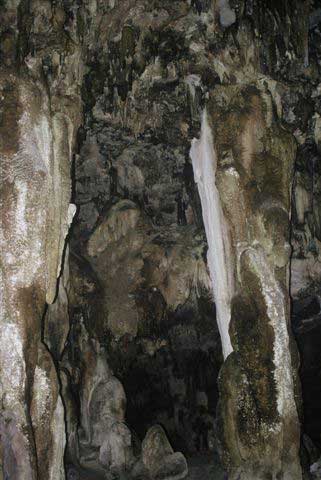
Gazing into the cave behind the Eyes of Tangaroa
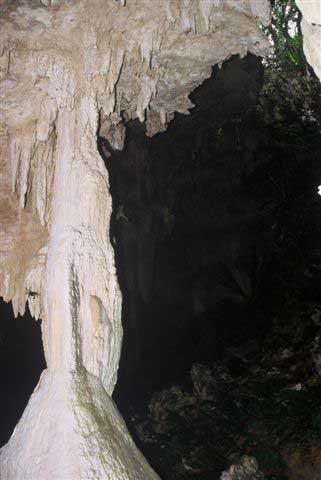
Enter the Kingdom of Bones
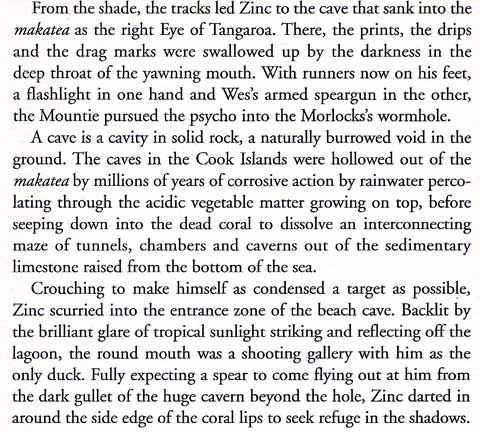

A Cook Islands ariki (sitting) (c. 1888 - 1910)
The ariki - chief - of Atiu kindly let a relative take Slade spelunking in a burial cave. They drove into the jungle on a motorbike, then used a machete to clear undergrowth tangling the way to a vertical pothole. By climbing down the tight, jagged-edged well, they reached a horizontal subterranean cave.
So claustrophobic was the dark tunnel that it reduced Slade to crawling in on his hands and knees. His guide led the way.
Lining the floor along both sides and tucked into crannies up the concave walls were heaped skeleton bones crowned with human skulls. No one knows if they died in battle or fell victim to cannibal feasts. Violent death was evident from holes in the craniums. Repeatedly, Slade's flashlight caught empty eyes and ivory grins.
From age, the bones were orange.
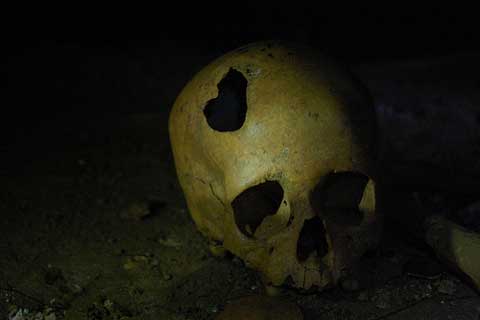
Atiu burial cave, photos by Fabvirge (licensed copyright)
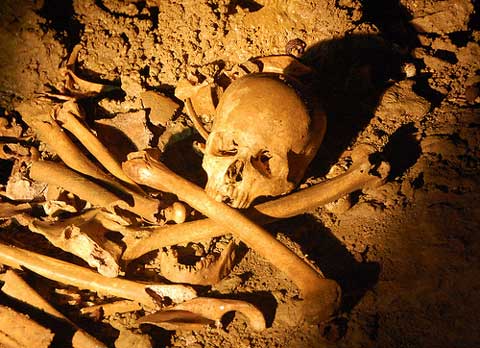
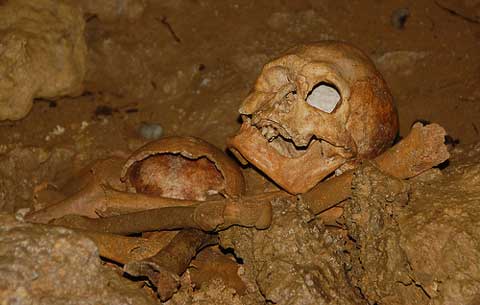
The deeper Slade crawled, the tighter his morbid imagination took hold. The Cook Islands were formed by upheavals under the sea. Today, earthquakes and tsunamis are common in the Pacific.
What if a tremor caused crumbling coral to seal the pothole escape, and seawater submerged the dark end ahead? Slade could slowly smother to death as depleting oxygen made him hallucinate that vengeful skeletons were reanimating for their own cannibal feast.
Alas, Slade's not as agile as when he climbed the Great Pyramid. In strugging to turn around in the cramped tunnel, he lost his balance, threw out a hand, and landed on a bone shard that pierced his palm. That's when the guide warned, "Don't touch the bones. They're cursed."
Cannibal curses are insufficient to give a rational man like Slade the heebie-jeebies. But if you swim in the Zambezi River of Zimbabwe, you may pick up flukes that burrow into your intestinal walls. And if you pee in the Amazon off the stern of a boat, a toothpick fish called a candiru may scoot up the warm stream and sink poisonous barbs into your urethra. And if you eat a 1,000-year-old egg in China, you may contract a bone fungus that will turn your skeleton to jelly and suffocate you with your unsupported organs.
Who knows what plague may lurk in cannibal bones that fester in tropical dampness for centuries?
Slade contemplated that horror as he downed too many beers in the guest house bar that night. Fitful sleep and nightmares tormented him in the dark. He awoke expecting to find his cursed arm a brittle black stick.
Instead, dawn found him scribbling in a frenzy on the veranda, and you can read all about it in BED OF NAILS.
Dinner is served.















